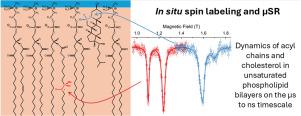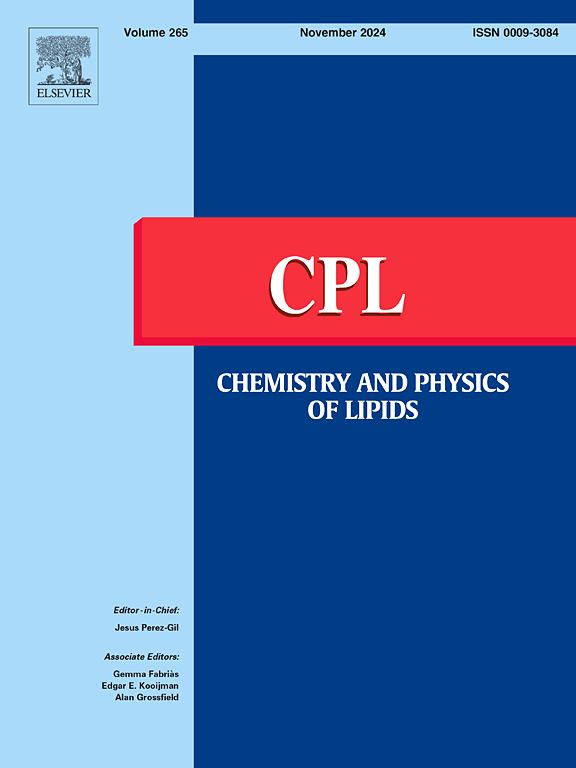Nanoscale dynamics in model phospholipid biomembranes probed by muon spin resonance spectroscopy: The effects of membrane composition and temperature on acyl chain and cholesterol motion
IF 2.8
3区 生物学
Q2 BIOCHEMISTRY & MOLECULAR BIOLOGY
引用次数: 0
Abstract
The physical properties of lipid bilayers are known to depend on their composition, but there has recently been controversy about whether cholesterol (chol) does or does not stiffen biomembranes containing unsaturated phospholipids. Herein, avoided level crossing muon spin resonance (ALC-SR) spectroscopy has been used to probe the local dynamics in model biomembranes composed of the saturated phospholipid 1,2-dipalmitoyl-sn-glycero-3-phosphocholine (DPPC), the unsaturated phospholipids 1-palmitoyl-2-oleoyl-glycero-3-phosphocholine (POPC) and 1,2-dioleoyl-sn-glycero-3-phosphocholine (DOPC), and the sterol chol. The presence of chol significantly stiffens the acyl chains in lipid mixtures as evident from the reduction of the amplitude of restricted reorientational motion in the acyl chain at the C-C10 position and the increase of the torsional barrier for rotation about the bonds in the acyl chain. Swapping POPC for DOPC slightly increases the amplitude of restricted reorientational motion and decreases the torsional barrier of the acyl chains, but the magnitude of the effect is much smaller than the inclusion of chol.

用μ子自旋共振光谱探测模型磷脂生物膜的纳米尺度动力学:膜组成和温度对酰基链和胆固醇运动的影响。
脂质双分子层的物理性质取决于它们的组成,但最近关于胆固醇是否会使含有不饱和磷脂的生物膜变硬一直存在争议。本文采用避免水平交叉μ子自旋共振(ALC-μSR)光谱,研究了由饱和磷脂1,2-二棕榈酰-2-油基-甘油-3-磷脂胆碱(DPPC)、不饱和磷脂1-棕榈酰-2-油基-甘油-3-磷脂胆碱(POPC)和1,2-二油基- asn -甘油-3-磷脂胆碱(DOPC)和甾醇组成的模型生物膜的局部动力学。从C9-C10位置的酰基链受限重定向运动幅度的减小和酰基链上键旋转的扭转势垒的增加可以看出,胆固醇的存在显著地使脂质混合物中的酰基链变硬。将POPC替换为DOPC略微增加了限制重定向运动的幅度,并降低了酰基链的扭转势垒,但其影响幅度远小于包含chol。
本文章由计算机程序翻译,如有差异,请以英文原文为准。
求助全文
约1分钟内获得全文
求助全文
来源期刊

Chemistry and Physics of Lipids
生物-生化与分子生物学
CiteScore
7.60
自引率
2.90%
发文量
50
审稿时长
40 days
期刊介绍:
Chemistry and Physics of Lipids publishes research papers and review articles on chemical and physical aspects of lipids with primary emphasis on the relationship of these properties to biological functions and to biomedical applications.
Accordingly, the journal covers: advances in synthetic and analytical lipid methodology; mass-spectrometry of lipids; chemical and physical characterisation of isolated structures; thermodynamics, phase behaviour, topology and dynamics of lipid assemblies; physicochemical studies into lipid-lipid and lipid-protein interactions in lipoproteins and in natural and model membranes; movement of lipids within, across and between membranes; intracellular lipid transfer; structure-function relationships and the nature of lipid-derived second messengers; chemical, physical and functional alterations of lipids induced by free radicals; enzymatic and non-enzymatic mechanisms of lipid peroxidation in cells, tissues, biofluids; oxidative lipidomics; and the role of lipids in the regulation of membrane-dependent biological processes.
 求助内容:
求助内容: 应助结果提醒方式:
应助结果提醒方式:


